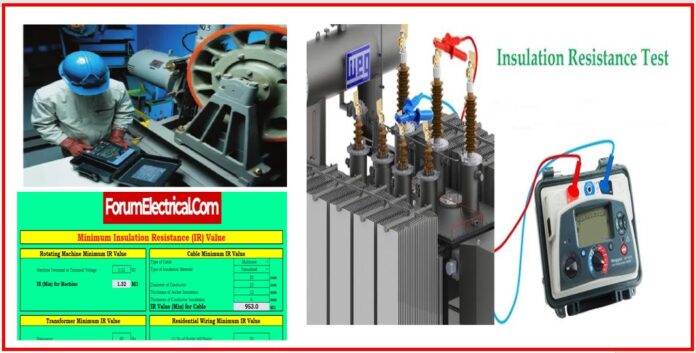Calculating insulating resistance is an important part of electrical maintenance & safety. This measurement contributes in determining the state of insulation in the electrical equipment & wiring, ensuring that it is free of defects or degeneration that could result in electrical failures or hazards.
Insulation resistance is measured using a megohmmeter, which is a high resistance range ohmmeter.
How to calculate Insulation Resistance?
Configuration of Equipment
Make ensure the electrical circuit or equipment being tested is de-energized and unplugged from the power source. When conducting testing on insulating resistance, safety comes first.
Determine the suitable Megohmmeter
Make sure the insulation resistance tester or megohmmeter chosen is appropriate for the system’s voltage rating. Varying voltage levels may be necessary for testing different systems.
Connect Tester
Attach the megohmmeter’s test leads in the following manner:
- To the conductor (or) test apparatus, there is one lead (positive).
- An established, reliable ground reference, like a ground rod (or) a grounded part of equipment, is the other lead (negative).
Set Voltage Level
Using the megohmmeter, select the proper test voltage according to the kind & voltage rating of system under test. Standard test voltages are in the range of 100V to 1,000V (or) higher.
Conduct the Testing
Switch on the megohmmeter so that the insulator receives the test voltage. Megohms (MΩ) will be used by the tester to measure the resistance. Stabilization of the test usually takes a minute (or) more, particularly during higher test voltages.
Take Note of the Reading
Take note of the megohmmeter’s insulation resistance reading. The value indicates the resistance that exists between the ground reference and the conductor.
Analyze the Result
Compare the insulating resistance value to manufacturer recommendations or industry standards for the particular equipment (or) system that are to be tested. Higher insulation resistance levels typically correspond to higher-quality insulation.
Modification of Temperature
Remember that temperature has the potential to affect the insulating resistance value. Certain megohmmeters have an automated temperature compensation feature, but others need to be manually adjusted or corrected in response to changes in temperature.
Pattern Evaluation
To create a baseline and monitor any changes, conduct insulation resistance testing on a regular basis over time. Insulation degradation may be detected early if there is a noticeable decrease in insulation resistance.
Repair and Maintenance
If the insulation resistance is less than acceptable thresholds, more research and remedial measures like cleaning, drying, (or) replacing the insulation can be required.
Attachment
Conclusion
The resistance between the conductor and ground must be measured using an insulation resistance tester (or) megohmmeter in order to determine the insulation resistance value.
Part of electrical maintenance & safety procedures, this test helps in locating possible insulation problems in electrical equipment. For particular applications, refer to applicable standards and manufacturer recommendations, and always observe safety protocols and instructions when conducting insulation resistance testing.









